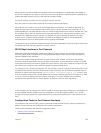
Member ports of a LAG are added and programmed into the hardware in a predictable order based on
the port ID, instead of in the order in which the ports come up. With this implementation, load balancing
yields predictable results across line card resets and chassis reloads.
A physical interface can belong to only one port channel at a time.
Each port channel must contain interfaces of the same interface type/speed.
Port channels can contain a mix of 10 or 40 Gigabit Ethernet interfaces. The interface speed (10, 40
Gbps) the port channel uses is determined by the first port channel member that is physically up. The
system disables the interfaces that do match the interface speed that the first channel member sets. That
first interface may be the first interface that is physically brought up or was physically operating when
interfaces were added to the port channel. For example, if the first operational interface in the port
channel is a 10–Gigabit Ethernet interface, all interfaces at 40Gbps are kept up, and all 10/40 GbE
interfaces that are not set to 1000 speed or auto negotiate are disabled.
The system brings up 10/40 GbE interfaces that are set to auto negotiate so that their speed is identical to
the speed of the first channel member in the port channel.
10/40 Gbps Interfaces in Port Channels
When both 10/40 interfaces GigE interfaces are added to a port channel, the interfaces must share a
common speed. When interfaces have a configured speed different from the port channel speed, the
software disables those interfaces.
The common speed is determined when the port channel is first enabled. At that time, the software
checks the first interface listed in the port channel configuration. If you enabled that interface, its speed
configuration becomes the common speed of the port channel. If the other interfaces configured in that
port channel are configured with a different speed, the system disables them.
For example, if four interfaces (TenGig 0/1, 0/2, 0/3 and 0/4) in which TenGig 0/1 and TenGig 0/2 are set
to speed 10 Gb/s and the others(te 0/3 and 0/4) are set to 40 Gb/s, with all interfaces enabled, and you
add them to a port channel by entering channel-member tengigabitethernet 0/1-4 while in port
channel interface mode, and the system determines if the first interface specified (TenGig 0/1) is up. After
it is up, the common speed of the port channel is 10 Gb/s. The system disables those interfaces
configured with speed 40 Gb/s or whose speed is 40 Gb/s as a result of auto-negotiation.
In this example, you can change the common speed of the port channel by changing its configuration so
the first enabled interface referenced in the configuration is a 10 Gb/s speed interface. You can also
change the common speed of the port channel here by setting the speed of the Te 0/0 interface to 10
Gb/s.
Configuration Tasks for Port Channel Interfaces
To configure a port channel (LAG), use the commands similar to those found in physical interfaces. By
default, no port channels are configured in the startup configuration.
These are the mandatory and optional configuration tasks:
• Creating a Port Channel (mandatory)
Interfaces
411


















